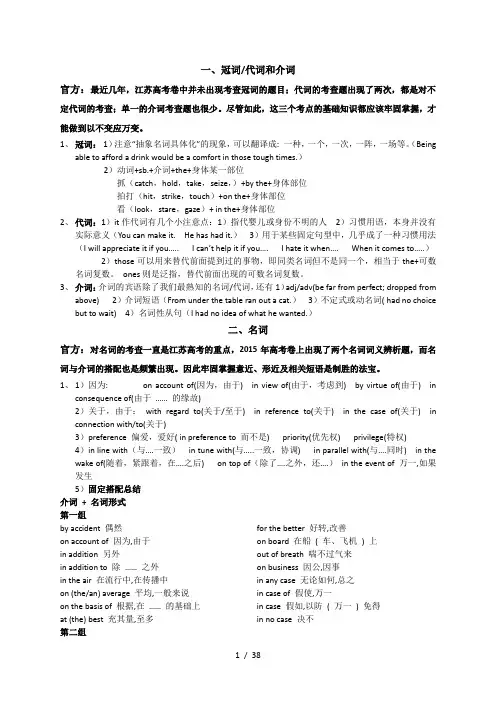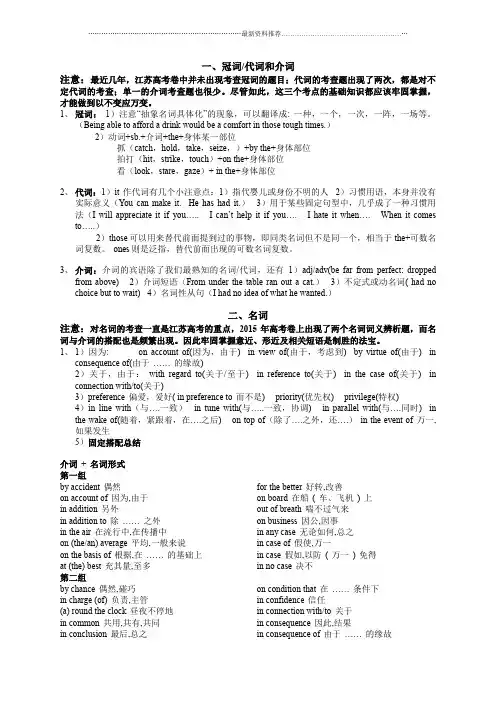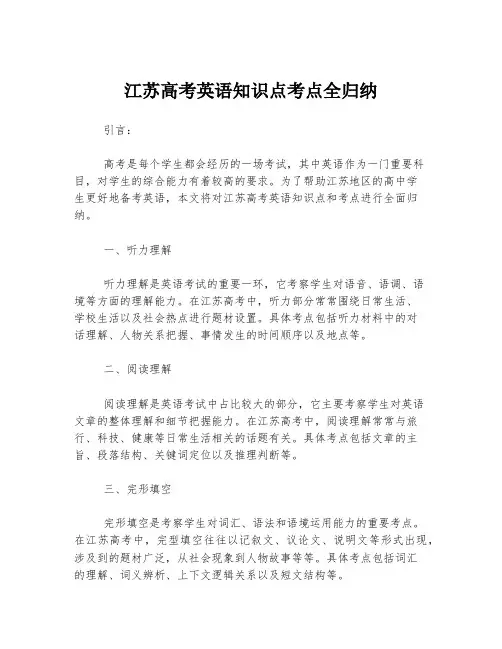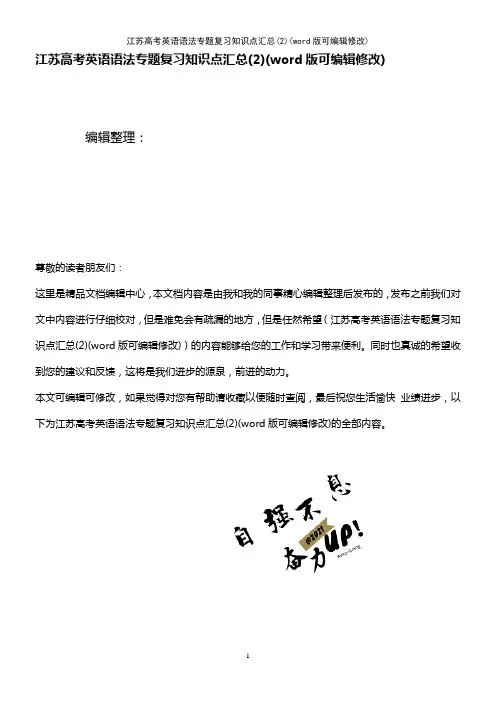江苏高考英语语法专题复习知识点汇总
最新江苏高考英语重点语法知识[易错点]
![最新江苏高考英语重点语法知识[易错点]](https://uimg.taocdn.com/4074a548f18583d049645999.webp)
一、冠词/代词和介词官方:最近几年,江苏高考卷中并未出现考查冠词的题目;代词的考查题出现了两次,都是对不定代词的考查;单一的介词考查题也很少。
尽管如此,这三个考点的基础知识都应该牢固掌握,才能做到以不变应万变。
1、冠词:1)注意“抽象名词具体化”的现象,可以翻译成: 一种,一个,一次,一阵,一场等。
(Being able to afford a drink would be a comfort in those tough times.)2)动词+sb.+介词+the+身体某一部位抓(catch,hold,take,seize,)+by the+身体部位拍打(hit,strike,touch)+on the+身体部位看(look,stare,gaze)+ in the+身体部位2、代词:1)it作代词有几个小注意点:1)指代婴儿或身份不明的人2)习惯用语,本身并没有实际意义(You can make it. He has had it.)3)用于某些固定句型中,几乎成了一种习惯用法(I will appreciate it if you….. I can’t help it if you…. I hate it when….When it comes to…..)2)those可以用来替代前面提到过的事物,即同类名词但不是同一个,相当于the+可数名词复数。
ones则是泛指,替代前面出现的可数名词复数。
3、介词:介词的宾语除了我们最熟知的名词/代词,还有1)adj/adv(be far from perfect;dropped from above) 2)介词短语(From under the table ran out a cat.)3)不定式或动名词( had no choice but to wait) 4)名词性从句(I had no idea of what he wanted.)二、名词官方:对名词的考查一直是江苏高考的重点,2015年高考卷上出现了两个名词词义辨析题,而名词与介词的搭配也是频繁出现。
最新-江苏省高考英语重点语法知识(易错点)

一、冠词/代词和介词官方:最近几年,江苏高考卷中并未出现考查冠词的题目;代词的考查题出现了两次,都是对不定代词的考查;单一的介词考查题也很少。
尽管如此,这三个考点的基础知识都应该牢固掌握,才能做到以不变应万变。
1、冠词:1)注意“抽象名词具体化”的现象,可以翻译成: 一种,一个,一次,一阵,一场等。
(Beingable to afford a drink would be a comfort in those tough times.)2)动词+sb.+介词+the+身体某一部位抓(catch,hold,take,seize,)+by the+身体部位拍打(hit,strike,touch)+on the+身体部位看(look,stare,gaze)+ in the+身体部位2、代词:1)it作代词有几个小注意点:1)指代婴儿或身份不明的人2)习惯用语,本身并没有实际意义(You can make it. He has had it.)3)用于某些固定句型中,几乎成了一种习惯用法(I will appreciate it if you….. I can’t help it if you…. I hate it when…. When it comes to…..)2)those可以用来替代前面提到过的事物,即同类名词但不是同一个,相当于the+可数名词复数。
ones则是泛指,替代前面出现的可数名词复数。
3、介词:介词的宾语除了我们最熟知的名词/代词,还有1)adj/adv(be far from perfect; dropped fromabove) 2)介词短语(From under the table ran out a cat.)3)不定式或动名词( had no choice but to wait) 4)名词性从句(I had no idea of what he wanted.)二、名词官方:对名词的考查一直是江苏高考的重点,2015年高考卷上出现了两个名词词义辨析题,而名词与介词的搭配也是频繁出现。
(word完整版)江苏高考英语重点语法知识讲解(易错点).doc

一、冠词 /代词和介词注意:最近几年,江高考卷中并未出考冠的目;代的考出了两次,都是不定代的考;一的介考也很少。
尽管如此,三个考点的基知都牢固掌握,才能做到以不万。
1、冠:1)注意“抽象名具体化”的象,可以翻成: 一种,一个,一次,一,一等。
(Being able to afford a drink would be a comfort in those tough times. )2) +sb.+介 +the+ 身体某一部位抓( catch, hold ,take, seize,) +by the+ 身体部位拍打( hit , strike,touch) +on the+ 身体部位看( look ,stare, gaze)+ in the+ 身体部位2、代: 1) it 作代有几个小注意点: 1)指代儿或身份不明的人2)用,本身并没有意( You can make it. He has had it. ) 3)用于某些固定句型中,几乎成了一种用法( I will appreciate it if you⋯ .. I can’t help it if you⋯ . I hate it when⋯ . When it comes to⋯ ..)2) those可以用来替代前面提到的事物,即同名但不是同一个,相当于the+可数名复数。
ones 是泛指,替代前面出的可数名复数。
3、介:介的除了我最熟知的名/代,有 1) adj/adv(be far from perfect; droppedfrom above) 2)介短( From under the table ran out a cat.)3)不定式或名 ( had no choice but to wait) 4)名性从句( I had no idea of what he wanted. )二、名词注意:名的考一直是江高考的重点,2015 年高考卷上出了两个名辨析,而名与介的搭配也是繁出。
江苏高考英语重点语法知识讲解(易错点)精编版

一、冠词/代词和介词注意:最近几年,江苏高考卷中并未出现考查冠词的题目;代词的考查题出现了两次,都是对不定代词的考查;单一的介词考查题也很少。
尽管如此,这三个考点的基础知识都应该牢固掌握,才能做到以不变应万变。
1、冠词:1)注意“抽象名词具体化”的现象,可以翻译成: 一种,一个,一次,一阵,一场等。
(Being able to afford a drink would be a comfort in those tough times.)2)动词+sb.+介词+the+身体某一部位抓(catch,hold,take,seize,)+by the+身体部位拍打(hit,strike,touch)+on the+身体部位看(look,stare,gaze)+ in the+身体部位2、代词:1)it作代词有几个小注意点:1)指代婴儿或身份不明的人2)习惯用语,本身并没有实际意义(You can make it. He has had it.)3)用于某些固定句型中,几乎成了一种习惯用法(I will appreciate it if you….. I can’t help it if you…. I hate it when…. When it comes to…..)2)those可以用来替代前面提到过的事物,即同类名词但不是同一个,相当于the+可数名词复数。
ones则是泛指,替代前面出现的可数名词复数。
3、介词:介词的宾语除了我们最熟知的名词/代词,还有1)adj/adv(be far from perfect; droppedfrom above) 2)介词短语(From under the table ran out a cat.)3)不定式或动名词( had no choice but to wait) 4)名词性从句(I had no idea of what he wanted.)二、名词注意:对名词的考查一直是江苏高考的重点,2015年高考卷上出现了两个名词词义辨析题,而名词与介词的搭配也是频繁出现。
江苏高考英语知识点考点全归纳

江苏高考英语知识点考点全归纳引言:高考是每个学生都会经历的一场考试,其中英语作为一门重要科目,对学生的综合能力有着较高的要求。
为了帮助江苏地区的高中学生更好地备考英语,本文将对江苏高考英语知识点和考点进行全面归纳。
一、听力理解听力理解是英语考试的重要一环,它考察学生对语音、语调、语境等方面的理解能力。
在江苏高考中,听力部分常常围绕日常生活、学校生活以及社会热点进行题材设置。
具体考点包括听力材料中的对话理解、人物关系把握、事情发生的时间顺序以及地点等。
二、阅读理解阅读理解是英语考试中占比较大的部分,它主要考察学生对英语文章的整体理解和细节把握能力。
在江苏高考中,阅读理解常常与旅行、科技、健康等日常生活相关的话题有关。
具体考点包括文章的主旨、段落结构、关键词定位以及推理判断等。
三、完形填空完形填空是考察学生对词汇、语法和语境运用能力的重要考点。
在江苏高考中,完型填空往往以记叙文、议论文、说明文等形式出现,涉及到的题材广泛,从社会现象到人物故事等等。
具体考点包括词汇的理解、词义辨析、上下文逻辑关系以及短文结构等。
四、语法填空语法填空是考察学生对语法知识掌握情况的考点。
在江苏高考中,语法填空题通常围绕名词、动词、形容词、副词、介词、连词等语法知识展开。
具体考点包括时态、语态、语气、主谓一致、非谓语动词、定语从句等。
五、写作能力写作能力是英语考试中需要学生展现的一项重要能力。
在江苏高考中,写作往往以日记、书信、便条及短文写作等形式出现。
具体要求包括语言表达准确、逻辑严谨、词汇丰富、句式多样以及结构完整等。
六、翻译能力翻译能力是考察学生对英汉互译以及中译英的掌握情况。
在江苏高考中,翻译常常涉及日常生活、文化交流等领域。
具体考点包括词语的准确运用、句子的连贯性以及语言的地道性等。
结语:通过全面归纳江苏高考英语的知识点和考点,可以帮助学生更好地备考英语,提高应试能力。
最重要的是,提醒学生要注重培养综合能力,在学习过程中注意培养听说读写的综合能力,不仅仅局限在传统的知识点上。
江苏高考英语语法专题复习知识点汇总(2)(K12教育文档)

江苏高考英语语法专题复习知识点汇总(2)(word版可编辑修改)编辑整理:尊敬的读者朋友们:这里是精品文档编辑中心,本文档内容是由我和我的同事精心编辑整理后发布的,发布之前我们对文中内容进行仔细校对,但是难免会有疏漏的地方,但是任然希望(江苏高考英语语法专题复习知识点汇总(2)(word版可编辑修改))的内容能够给您的工作和学习带来便利。
同时也真诚的希望收到您的建议和反馈,这将是我们进步的源泉,前进的动力。
本文可编辑可修改,如果觉得对您有帮助请收藏以便随时查阅,最后祝您生活愉快业绩进步,以下为江苏高考英语语法专题复习知识点汇总(2)(word版可编辑修改)的全部内容。
江苏高考英语语法专题复习知识点汇总一、冠词The Article知识要点:冠词是一种虚词,放在名词的前面,帮助说明名词的含义。
冠词分不定冠词(The Indefinite Article)和定冠词(The definite Article)两种。
a (an) 是不定冠词,a用在辅音之前:如a book, a man; an用在元音之前,如:an old man, an hour, an interesting book等。
the 是定冠词。
一、不定冠词的用法1、指人或事物的某一种类(泛指)。
这是不定冠词a (an)的基本用法。
如:She is a girl.I am a teacher。
Please pass me an apple。
2、指某人或某物,但不具体说明何人或何物。
如:He borrowed a story—book from the library.A Li is looking for you。
一位姓李的同志正在找你。
3、表示数量,有“一"的意思,但数的概念没有one强烈.如:I have a mouth, a nose and two eyes。
4、用于某些固定词组中。
如:a bit, a few, a little, a lot of, a piece of, a cup of, a glass of, a pile of, a pair of, have a good time, for a while, for a long time等。
江苏高考高三英语语法知识复习
高三英语语法知识复习复合句一、名词性从句名词性从句相当于名词;可分别在句中作主语、表语、宾语和同位语..可分为主语从句、表语从句、宾语从句和同位语从句..从属连词that:在从句中不充当任何成分;也没有任何意思;只起连接作用;有时可以省略从属连词if; whether:在从句中不充当任何成分;有意义;不可以省略连接代词who; whoever; whom; whomever; which; whichever; what; whatever; whose:在从句中充当成分;有意义;不可以省略连接副词where; when; why; how:在从句中充当成分;有意义;不可以省略一、主语从句1.由从属连词引导的主语从句:①Whether the country should build a nuclear power station is something we must discuss.那个国家是否应该建立核电站……②That light travels in straight line is known to all .光以直线传播….2.由连接代词引导的主语从句:①What we need is more time. 我们所需要的是……②Whichever book you choose doesn’t matter to me.无论你选哪本书……3.由连接副词引导的主语从句:①When the plane is to take off hasn’t been announced.飞机什么时候起飞……③How much water is flowing can be measured easily.水的流量是多少……4.关于形式主语 it①It + be +形容词+ that-从句It is necessary that…有必要…… It is importantthat…重要的是…It is obvious that…很明显…… It is likely that….很可能②It + be + -ed 分词+ that-从句It is believed that…人们相信……It is known to all that…众所周知…It has been decided that…已决定……③It + be +名词+ that-从句It is common knowledge that………是常识It is a surprisethat…令人惊奇的是……It is a fact that…事实是…… 可应用于此句型的名词还有fact / shame/ honor / question/pity等..④ It +不及物动词+ that-分句It appears that…似乎……It happens that…碰巧…… Itoccurred to me that…我突然想起……二、表语从句可以接表语从句的连系动词有 be; look; remain;seem 等..The problem is that millions of people die of illnesses causedby smoking.……数百万人死于由抽烟引起的疾病The question remains whether we can win the game…..我们是否能赢得这次比赛值得注意的是:1. 表语从句的表现形式除了用从属连词;连接代词和连接副词引导以外;还可以由as; as if ;as though引导. It looks as if it isgoing to rain. 好象要下雨了..2、另外还要注意以下常用的两种结构:The reason why…is that …而不用 becauseIt This; That is because…The reason why he was dismissed is that he didn’t work hard.他为什么被开除是因为他工作不努力..三、同位语从句同位语从句一般由 that; whether 等连词引导;常放在 advice; doubt; fact; hope; idea; information;message; news; order; possibility; problem; question; reason; truth;word; suggestion.等名词的后面;说明该名词的具体内容..l. The news that he had landed on the moon spread all over the world. 登陆月球…….2. I have no idea when he will be back. ……什么时候回来3. The thought came to him that Mary had probably fallen ill……Mary也许病了四、宾语从句宾语从句可以作及物动词的宾语;介词的宾语;某些形容词的宾语以及非谓语动词的宾语..1.及物动词后的宾语从句:She will give whoever needs help a warm support……任何需要帮助的人……I wonder why she refused my invitation……她为什么拒绝了我的邀请2.介词后的宾语从句:I always think of how I can improve my spoken English.我总是在思考如何提高我的口语水平..The teacher is satisfied with what she has said. 老师对他所说的话很满意..3.某些形容词后的宾语从句:I am sure that you will make greater progress in English through hard work.……通过努力工作;你将取得更大的进步We are surprised that he has left without saying goodbye to us…….他没有告别就走了4.非谓语动词后的宾语从句:Realizing that it was just a difference in custom; the foreigner smiled and said nothing.5.关于形式宾语itWe must make it clear that anyone who breaks the law will be punished.I find it necessary that we should ask him for his advice.我发现我们有必要征求他的意见..五、名词性从句重难点1. 在名词性从句中;疑问句要用陈述句的语序..例如:①Can you make sure ____the gold ring MET90A.where Alice had putB.where had Alice putC.where Alice has putD.where has Alice put2. 动词 doubt 用在疑问句或否定句中;其后宾语从句常用 that 作连接词;用在肯定句中;连接词用 whether 或 if 皆可;而不用 that..Do you doubt that he will win I don't doubt that your proposition is wrong .3. 否定转移问题..①将think; believe; suppose; expect; fancy; guess; imagine等动词后面跟宾语从句时否定转移I don't think I know you. 我想我并不认识你.. I don' t believe he will come. 我相信他不回来..We don't expect he will come tonight ; will he注意:若谓语动词为hope;宾语从句中的否定词不能转移.. I hope you weren't ill. 我想你没有生病吧..②将seem; appear 等后的从句的否定转移It doesn't seem that they know where to go. 看来他们不知道往哪去..It doesn't appear that we'll have a sunny day tomorrow. 看来我们明天不会碰上好天气..4. 主谓一致问题..What he wanted to see was an end to all the armies of the world.What I bought were three English books.5. 语气问题①在含有 suggest ; order ; demand ; propose ; command ; request ; insist; desire; require; advise 等表示要求、命令、建议、决定等意义的动词后;that从句常用“should+ 动词原形”的结构I suggest we should set off at once. 我建议我们应该立刻出发..②在It is +过去分词+that的主语从句中decided;demanded;desired;insisted;ordered;proposed;suggested;re commended;requested; required等..It is desired that weshouldget everything ready this evening.③在表语从句或同位语从句中The suggestion that the mayor should present the prizes was accepted by everyone.④在It iswas+形容词+that从句中要用虚拟语气;即should +动词原形;表示建议或不满、惊奇等情绪..常用于此类的形容词有essential;important;natural;necessary;possible;strange;等.. It is necessary that a college student ____at least a foreign language.上海1993A.mastersB.should masterC.masteredD.will master6.What引导名词从句的特殊含义:What was once regarded as impossible has now become a reality.what为“所……的事”;相当于“the thing that…;all that…;everything that…”After ________ seemed a very long time;I opened my eye and found myself in bed.M ET'93A.whatB.whenC.thatD.whichwhat相当于“the time that”;表示“……时间”He is not what he was a few years ago. Who is it that has made Fred what he is nowwhat表示“……的人”;相当于“the person that…”What is now the North Sahara Desert was once a civilized world.what表示“……的地方”;相当于“the place that…”Our income is now double what it was ten years agowhat表示“……的数目”;相当于“the amount /number that…”7.不可省略的连词:①介词后的连词不可省略如:Before I came downstairs I had prepared myself very carefully for what I must say.②引导主语从句和同位语从句的连词不可省略如:That she was chosen made us very happy.她被选上了;我们很高兴..We heard the news that our team had won. 我们听到消息说我们队赢了..8.比较:whether 与if 均为“是否”的意思..但在下列情况下;whether 不能被if 取代:①whether 引导主语从句在句首 Whether she comes or not doesn’t concern me .②引导表语从句 His first question was whether she had arrived yet. 他问第一个问题就是她来了没有..③引导同位语从句 Answer my question whether you are coming.回答我你是否来的问题..④whether 从句作介词宾语 I worry about whether I hurt her feeling .我担心是否伤了她的感情..⑤与or not连在一起I don’t know whether or not he is goingto Japan.我不知道他是否去日本..大部分连接词引导的主语从句都可以置于句末;用it 充当形式主语..例如:It is not important who will go. 谁去;这不重要..It is still unknown which team will win the match. 到底谁赢呢;形势尚不明朗..二、状语从句状语从句是一种副词性从句;通常由一个从属连词或一个起连词作用的词组引导..1.时间状语从句由下列连词引导:when; while ; as; before; after; once; till; until; once; as soon as; now that; hardly…when; scarcely…when; no sooner…than;有一些表示时间的副词短语或名词短语也可引导时间状语从句..如:directly; instantly; immediately; by the time;the moment; the second; the minute; the instant; every time; each time; next time; the last time等注意点如下: 1when; while; as引导的时间状语从句as表示“当……的时候”;往往和when/ while通用;但它着重强调主句与从句的动作或事情同时或几乎同时发生..①She came up as I was cooking.同时② When I was walking down the street; I came across an old friend of mine.在街上走时;碰到一位老朋友whenat or during the time that 既可以表示在某一点的时候;又可表示在某一段时间内;主句与从句的动作或事情可以同时发生也可以先后发生..①It was raining when we arrived.指时间点②When we were at school; we went to the library every day.在一段时间内③When we arrived there; the film had already begun.先后发生While强调一段时间里;仅表示从句和主句的动作同时发生;并且有延续意义;该从句中的动词一般要用延续性动词;从句中常用过去进行时态或一般过去时态;在when表示a period of time时;两者可以互换..①Please don’t talk so loud while/when others are working. 其他人工作时请不要大声讲话..②He fell asleep while/when reading. 读书时他睡着了..③ While they were watching TV; I was preparing myself for the coming examination.Strike while the iron is hot. 不可用as或when;这里的while意思是“趁……”as表示主从句动作同时发生;所以常译作"一边…一边"..John sings as he works.当When引出的时间状语从句为系表结构;而且其主语和主句的主语一致;其表语又是一个名词时;就可以用 as 引导的省略句来代替..When he was a young man = As a young man he was fond of hunting.2.原因状语从句由下列连词引导:as; because; since; now that; considering that; seeing that鉴于---..下面几点值得注意:1)because语气最强;用于回答why的提问;可与强调词only; just 以及否定词not 连用..但不可以与so连用..如You shouldn’t get angry just because some people speak ill of you.He failed because he was careless. 他因粗心而失败了..because引导的从句可以被强调:It was because she wanted to study abroad that she entered for TOEFL2 since引导的从句语气次于because引导的从句;常表示稍加分析后而推断出的原因;或指人们已知的事实;比as正式一些;常置于句首..as语气最弱;其原因只是对结果的附带说明;一般放在句首..Since/ Now that no one is against it ;let’s carry out the plan.As all the seats were full; he stood there. 所有的座位都满了他只好站那儿..3 for虽解释为“因为”但只是一个并列连词;它也常引导句子表原因;但不是原因状语从句;它是一个并列句..for所提供的理由是一种补充性的说明;表推测的理由..The day was short; for it was December.She must have cried for her eyes are red. 她一定哭过了;她眼睛红的..3.地点状语从句由下列连词引导:where; wherever;anywhere; everywhere..You are free to go wherever you like. 你可以去你想要去的任何地方..Anywhere he went; he got warm welcome. 无论他走到哪儿;都收到热烈欢迎..Where there is a will; there is a way. 有志者事竟成..4.结果状语从句由下列连词引导:that;so…that;such…that;so that等..注意以下几种结构:1.so+adj/adv+that…2.sucha/an+adj+n+that…3.so+adj+a/an+n+that=such a/an+adj+n+that…4.so many/much/few/little少+n+that…5such +adj +n u /pl + thatHe spoke so fast that I couldn’t follow him. 他说的如此的快;我跟不上他..It was such a lovely day / so lovely a day that we all went swimming天气好;我们大家都去游泳了..So或such置于句首时;主句常倒装..It was such a lovely day / so lovely a day that we all went swimming .=Such a lovely day was it that we all went swimming.注意以上结构与定语从句so/such…as的区别..This is such an interesting/so interesting a film that everyone wants to see it.This is such an interesting/so interesting a film as everyone wants to see.5.目的状语从句由下列连词引导:so that; in order that; for fear that; in case 等..注:so that也可用来引导结果状语从句 so that; in order that引导的目的状语从句中常需用情态动词..so that引导的目的状语从句只能放在主句之后;in order that 引导的目的状语从句可以放在主句之前或之后..We set out early so that we could see the sunrise. 我们很早出发以便能看到日出He sent the letter by air mail so that it might reach them in time. 他空邮这份信的以便他们能按时收到..for fear that; in case 引导的目的状语从句谓语动词要用should do 它们本身带有否定意义;相当于so that--not; in order that---not We hid behind the bushes in case /for fear that passers-by should see us. 我们躲在丛林中以防过路人看见..Please remind me of it again tomorrow in case I forget. 明天请再次提醒我以防我忘了..6.条件状语从句分为真实条件句和非真实条件句用在虚拟语气中..由下列连词引导:if; unless; suppose; supposing; providingthat;providedthat;giventhat;in case; on condition that; as long as; so long as; so far as等..1Unless=if not You will fail unless you study hard. 除非努力否则你就要失败..2suppose; supposing; providingthat;providedthat;giventhat= if Suppose I don’t have a day off; what shall I doGiven that he supports us; we’ll win the election. 如果他支持我们;我们就会赢得选举..3 on condition that; as long as; so long as = only ifAs long as you don’t lose heart; you will succeed. 只要你不灰心;你就会成功..4 As far as I know; he cheated in the exam.As far as I’m concerned ; making money is not the only purpose of life.7.让步状语从句由下列连词引导:although; though; as; even if; even though ;while; whether…or; whoever; what ever; however; no matter+疑问词等..注意以下几点:1)although; though引导让步状语从句时;主句前不能用but;但可以加yet; still..Though it was raining hard; yet they didn’t stop working. 尽管下着大雨;他们仍然在工作..2)as引导让步状语从句时;必须用前置结构;通常是从句中的表语、状语或动词原形放在句首;放在句首的名词前的冠词要去掉..Though he is a child; he knows a lot.=Child asthoughhe is; he knows a lot.在child前不要用冠词Good as he is ; he won’t be top of class.Though I like it very much; I won’t buy it.=Much as I like it;I won’t buy it.Try as he would; he couldn’t lift the heavy box.3)whether ---or not 引导的从句;提供两个对比的“尽管”情况; 含有条件意味..Whether you believe it or not; it is true. 信不信由你; 这是真的..Whether you come here or we go there ; the topic of discussion will remain unchanged.4)疑问词+ever=no matter +疑问词Whoever you are; you must show your pass. 无论你是谁;你都必须出示你的通行证..Whenever you come; you are welcome. 无论你啥时来;都欢迎..8.方式状语从句由下列连词引导:as; as if; as though ;the way等..At Rome we must do as the Romans do. 入乡随俗Do it the way you were told to. 教你怎样做就怎样做..He treats me as if I were a stranger. 他对待我象陌生人一样..注意以下几点:1as引导方式状语从句时意义为“按照”;“如同”;前面常用加强语势..I did it just as you told me.= I did it just as told toHe didn’t win the match as expected. 他没有像预料的一样赢得比赛..2)as if和as though 引导的从句中;谓语常用虚拟语气;有时也用陈述语气..It seems as if it were going to rain.3连词while 和whereas 可表示对比..Whereas he is rather lazy; she is quite energetic.注意状语从句中的省略现象1连接词+过去分词Unless repaired; the washing machine is no use.Though _______or many times; David often drives after drinking.A. to be warnedB. having been warning C warned D. being warned2连词+现在分词 Look out while crossing the street.3连词+形容词/其他常见的有if necessary、if possible、when necessary、if any等4比较状语从句中的省略句..如:He arrived home half an hour earlier than he had beenexpected.三、定语从句一、定语从句与引导词定语从句是在复合句中修饰某一名词或代词的从句..被修饰的名词或代词叫做选行词;而引导定语从句的词叫引导词;有关系代词和关系副词两类..关系词一共有九个;它们在从句中所充当的句子成分见下表..懂得什么样的先行词后用什么样的引导词是学好定语从句的关键..1.关系代词有:that;which;who;whom;whose;在定语从句中作主语、宾语中表语;whose作定语..代人的有:who;whom;whose;that;代物的有:that;which;whose.The man who helped you is Mr White.who代人;在定语从句中作主语That is the personwhom/who/that you want to see.whom;who;that指代人;在定语从句中作宾语;可省略I′m not the foolthat you thought me to be.that代人;在定从中作表语A dictionary is a useful book which=that tells us the meaning of wordswhich或that代物;在定从中作主语2.关系副词有:when指时间;where指地点;why指原因;在定语从句中作状语..例如:Would you suggest a timewhen we can have a talkwhen可省略The house where they live is not very large./This is the reason why he did not came to the meeting.注意:不是表时间的先行词都用when引导定从;不是表地点的先行词都用where引导定从..例如:We′ll visit the factory which=that makes radios.which或that在定从中作主语;where不可用主语;故不可用They still remember the happy dayswhich/that they spent in Beidaihe.which或that在定从中作spent的宾语;when不可作宾语;故不可用注意:①先行词是表示地点的名词时country; school; ro om…;而关系词代替先行词在定语从句中充当地点状语;一般用where引导定语从句..也可以用介词+which的结构..值得注意的是which前介词的选择是根据先行词与介词的搭配关系而定..The room where=in whichhe used to live has now been turned into a museum.The desk where=on whichI put my bag is his.②先行词是表示时间的名词year; month; day; night…;而关系词代替先行词在定语从句中充当时间状语;一般用when引导定语从句..也可以用介词+which的结构..值得注意的是which前介词的选择是根据先行词与介词的搭配关系而定..应特别注意:介词的位置变化以及相应的关系词的变化..请看下面两个句子..那就是他工作的大学..┏ at which he works.┣ which he works at.That is the college ┣ where he works.┣ that he works at.┗ he works at.它出生的那一天是1952年8月20日..┏ on which he was born┣ which he was born onThe day ┣ when he was born was Aug.20;1952.┣ that he was born on┗ he was born on二、限制性定语从句与非限制性定语从句限制性定语从句和主句之间不用逗号分开;修饰主句中的某一个名词或名词词组或代词;非限制性定语从句常用逗号和主句隔开;可以修饰主句中的某一个词;也可修饰整个句子..非限制性定语从句不能用that引导;引导非限制性定语从句的关系词不能省略..非限制性定语从句例:Li Ping’s father; who works in a factory; is an engineer./He tore up my photo; which made me very angry.which指代主句内容;因前后两句是因果关系;此时which不可换为as..He is good at physics; as is known to us all.=As is known tous all; he is good at physics.as指代主句内容;在as is known/believed; as we all know/believe这类结构中as不可换为which三、只用that引导和不用that引导的场合1.只用that引导的场合1)当先行词既包括人又包括物时:He talked about the men and the books that attracted him.2)指物的先行词被any; every; only; very; all; no等修饰时:These are the very points that interest me./That's the only watch that I like most.3)指物的先行词被序数词或形容词最高级修饰时:The first step that we are to take is very difficult./This is the second card that he gave me.4)先行词是指物的不定代词all; little; few; much;及everything; anything; nothing等时:There is still much that can be done about it./Have you got everything that you need5)先行词是who时:Who that have seen him does not like him2.不用that的场合如下:1非限制性定语从句中 Last night ;I saw a very good film; which was about the Long March .2介词放在关系代词之前时 This is the man from whom I learnt the news3句中出现了that;或先行词是that时 I have found that whichI was looking for.四、“介词+关系代词”用法1.介词的确定应依据定语从句中短语的习惯性搭配;例如:Who is the girl with whom you just shook handsshake hands with…是习惯性搭配2.介词常受先行词的制约即介词和先行词的搭配;例如:He built a telescope through which he could study the skies.through which 即through the telescope3.当关系代词作“动词+介词”固定短语的宾语时;此时因定短语中的介词不能拆开移到关系代词前..例如:This is the watch which you’re looking for./He is a kind of man whom you can safely depend on.五、几个名词后的引导词1.situation后常用where; in which引导定语从句Can you imagine a situation where/in which you can use the word2.way后面的定语从句;引导定语从句有三种情况:a.在比较正式的文体中用in whichI was struck by the beauty of the way in which she stood.It was clear that the speaker now trusted Tom from the way in which these words were said.b.一般情况下用thatLincoln asked the people to think of slavery in the way that these men did.Mary;there is one way that you could stop others talking about you and criticizing you.c.in which和that省去..That's the way I looked at it.The assistant who served her did not like the way she was dressed.六、关于as引导的定语从句的问题as引导定语从句主要用于非限制性定语从句和the same…as;such…as;as…as的结构中..1.as与which都可以引导一个非限制性定语从句;并代表前面整个句子或主句中的表语..He married the girl;aswhichwas natural.He seemed a foreigner; aswhichin fact he was.不同的是:as引导的定语从句可以前置;而which不行..As was natural; he married the girl.在the same…as; such…as; as…as结构中;same; such; as之后应是名词或形容词+名词..We are facing the same problems as we did years ago.Some people have no doubt that their cat understands as many words as a dog does.We hope to get such a tool as he is using.这三种结构也可以用which改写..但要去掉这种结构;不能直接用which代替as..以上三句分别可以改写成:We are facing the problems which we faced years ago.Some people have no doubt that their cat understands the words which a dog understands.We hope to get the tool which he is using.the same…as与the same…that引导的定语从句在意义上的区别是:前者修饰的是与原物同样的;而后者修饰的就是先行词同样的东西..比较:This is the same watch as I lost.这和我丢失的那一只表一样..不是同一只This is the same watch that I lost.这就是我丢失的那一只表..同一只定语从句与其他从句或句型的区分一、定语从句与并列句用一个恰当的词完成下列句子;使之完整与正确..①Mr Li has three daughters;none of _____ is an engineer.②Mr Li has three daughters;but none of _____ is a dancer.③Mr Li has three daughters;_____ are doctors.解析:定语从句与并列句的主要区别在于:并列句有像and;but;so 等并列连词或两个句子用分号连接;这时就不能再用引导定语从句的关系词了..从结构上看;①小题是定语从句;故填whom;②小题有并列连词but;是并列句;故填代词 them;③小题是两个并列分句;无需连接词;缺少主语;故填none或they..二、定语从句与状语从句1.定语从句的前面有名词作先行词;而状语从句没有先行词..This is the place where we used to live a few years ago. 这是几年前我们居住的地方..定语从句;先行词为the placeLet’s go where we can find a better job. 我们到能找到更好的工作的地方去吧..地点状语从句2.定语从句修饰、限制、说明名词;只能放在先行词的后面;而状语从句说明动作发生的情况;并且可以放在主句的前面..Do you know the time when the class is over 你知道下课的时间吗定语从句It was already five o’clock when the class was over.=When the class was over; it was already five o’clock. 当下课时己经是5点了..时间状语从句3.When; where和why在引导定语从句时可以用“介词+which”的结构来替换;在引导状语从句时却不行..This is the factory in which where his father once worked. 这就是他的父亲曾经在那里工作过的那个工厂..定语从句Put back the book where it was. 把书放回原处..状语从句4.定语从句中的关系词在从句中充当某种句子成分;因此去掉它则从句成分不完整;而结果状语从句中的连接词在从句中不作任何成分;去掉后从句的成分仍然完整..如:It is such an interesting book as we all like. 它是我们大家都喜欢的如此有趣的书..as用作动词like的宾语;它引导的是定语从句It is such an interesting book that we all like it. 它是一本如此有趣的书;我们大家都喜欢它..that不充当句子成分;故它引导的是结果状语从句三、定语从句与同位语从句定语从句和同位语从句在形式结构上基本相同;都跟在名词或代词之后;且又常由that引导..但它们的句法功能却不相同..我们可以从以下几个方面把它们区别开来:1.先行词的范围不同定语从句的先行词范围很广;可以指人、物等;没有限制;同位语从句的被修饰词通常是少数一些表示抽象意义的名词;不指人..同位语从句修饰的词常见的有:belief; doubt; fact; hope; idea; news; thought; order; suggestion; wish; answer; information; conclusion; decision; knowledge; opinion; problem; promise; question; plan; report; truth; view等..例如:This is the place that / which we visited yesterday . 这就是昨天我们参观过的地方..定语从句The text tells us a fact that smoking does great harm to people’s health .这篇课文又告诉我们一个事实;吸烟对健康危害很大..同位语从句I had no idea when the sports meet will take place. 我不知道运动会何时举行..同位语从句2.从句和先行词的关系不同定语从句在复合句中相当于形容词;对先行词起修饰、描述或限制的作用;与先行词之间有从属关系..同位语的作用相当于名词;对前面的名词给予补充说明或进一步解释;是前面名词的具体内容;与先行词之间是同位关系..例如:The news that she had passed the exam made her parents very happy.她考试及格的消息使她父母很高兴..同位语从句此句中的同位语从句 The news that she had passed the exam可以改写成表语从句:The news is that he passed the exam.The news that he told us interested all of us. 他告诉我们的消息使大家都感兴趣..定语从句The news that he told us 是定语从句;此句就不能改写为:The news is that he told us.3.引导词及其作用不同引导定语从句的词是关系词;常见的关系词有that ; which ; who ; whose ; whom ; when ; where ; why ; as 等..关系词除了连接主从句的作用外;还在定语从句中充当一定的句子成分;如主语、宾语、状语、定语、表语等..引导同位语从句的that只起连接主从句的作用;不在从句中担任任何成分..what; whether 和 how 可以引导同位语从句;但不能引导定语从句..例如:The fact thatwhich we talked about is very important.我们所谈论的那个事实很重要..定语从句;that在从句中作about的宾语The fact that he succeeded in the experiment pleased everybody.他实验成功这个事实使我们大家很高兴..同位语从句;that只起连接作用三、定语从句与强调句用一个恰当的词完成下列句子;使之完整与正确..①It is on the morning of May 1st _____ I met Liang Wei at the airport.②It is the factory _____ Mr Wang works.解析:定语从句与强调句的主要区别在于:强调句的结构为“It is /was+被强调部分+that+从句”..被强调部分可以是除谓语以外的任何成分;当被强调部分是人时;还可用who代替that..这一句型中;一定不能因为被强调部分是表时间或地点的词就用when或where代替 that..从结构上看;①小题是强调句;故填 that..此种情况检测的标准是:先把强调句中的It is/was去掉;再把被强调部分还原;在不增加或减少任何单词的情况下;如句子仍然成立则为强调句;否则为定语从句..将第①小题改为:I met Liang Wei on the morning of May 1st at the airport.显然;这句话是正确的;故为强调句..②小题则是定语从句;用上述方法转换。
江苏高考英语重点语法知识讲解易错点
一、冠词/代词和介词注意:最近几年,江苏高考卷中并未出现考查冠词的题目;代词的考查题出现了两次,都是对不定代词的考查;单一的介词考查题也很少。
尽管如此,这三个考点的基础知识都应该牢固掌握,才能做到以不变应万变。
1、冠词:1)注意“抽象名词具体化”的现象,可以翻译成:一种,一个,一次,一阵,一场等。
(Beingabletoaffordadrinkwouldbeacomfortinthosetoughtimes.)2)动词+sb.+介词+the+身体某一部位抓(catch,hold,take,seize,)+bythe+身体部位拍打(hit,strike,touch)+onthe+身体部位看(look,stare,gaze)+inthe+身体部位2、代词:1)it作代词有几个小注意点:1)指代婴儿或身份不明的人2)习惯用语,本身并没有实际意义(Youcanmakeit.Hehashadit.)3)用于某些固定句型中,几乎成了一种习惯用法(Iwillappreciateitifyou…..Ican’thelpitifyou….Ihateitwhen….Whenitcomesto…..)2)those可以用来替代前面提到过的事物,即同类名词但不是同一个,相当于the+可数名词复数。
ones则是泛指,替代前面出现的可数名词复数。
3、介词:介词的宾语除了我们最熟知的名词/代词,还有1)adj/adv(befarfromperfect;droppedfromabove)2)介词短语(Fromunderthetableranoutacat.)3)不定式或动名词(hadnochoicebuttowait)4)名词性从句(Ihadnoideaofwhathewanted.)二、名词注意:对名词的考查一直是江苏高考的重点,2015年高考卷上出现了两个名词词义辨析题,而名词与介词的搭配也是频繁出现。
因此牢固掌握意近、形近及相关短语是制胜的法宝。
江苏高考英语知识点归纳
江苏高考英语知识点归纳江苏高考英语作为高中生升入大学的重要一关,涵盖了丰富的英语知识和技能。
在备考过程中,熟悉并掌握各个知识点是极为关键的。
本文旨在对江苏高考英语的知识点进行归纳总结,帮助考生有针对性地复习备考。
一、语法部分语法是英语学习的重点和难点,也是许多考生容易出错的地方。
江苏高考英语中常考的语法知识点主要有:1. 时态和语态:包括一般现在时、一般过去时、一般将来时、现在进行时、过去进行时、过去将来时、现在完成时、过去完成时、被动语态等。
2. 从句:主要包括宾语从句、定语从句、状语从句等。
3. 名词性从句:主要包括主语从句、宾语从句、表语从句等。
4. 倒装句:主要包括部分倒装和全部倒装,如:Only in this way can we solve the problem.5. 各类从句的连接词:如although, as, unless, since, if等。
通过系统地学习这些语法知识点,并多做相关练习,可以帮助考生在语法选择题上取得高分。
二、阅读理解部分阅读理解是江苏高考英语考试的重头戏,占比较大,考察考生的阅读理解能力和综合运用能力。
而阅读理解的知识点主要涉及以下几个方面:1. 主旨大意:考生需要通过阅读短文,准确把握文章的主题和大意,可以通过研读标题、首句、末段等来帮助理解。
2. 细节理解:在文章中,会有一些与文章内容相关的具体细节信息,考生需要通过细致的阅读,找到与问题相关的答案。
3. 推理判断:有时,文章中的信息并不是显而易见的,考生需要通过理解和推理来得出正确的判断。
4. 词义猜测:在阅读过程中,考生会遇到一些不熟悉的单词或短语,需要通过上下文来推测其意思。
5. 修辞手法:在文章的表达中,常常会用到各种修辞手法,如比喻、夸张等,考生需要通过阅读理解这些修辞手法,理解文章的深层含义。
通过多读文章,掌握不同类型的阅读技巧,并进行大量的阅读练习,可以帮助考生提高阅读理解的能力。
三、写作部分写作考察的是考生的英语表达能力和思维逻辑能力。
江苏高考英语语法专题复习知识点汇总(K12教育文档)
(直打版)江苏高考英语语法专题复习知识点汇总(word版可编辑修改) 编辑整理:尊敬的读者朋友们:这里是精品文档编辑中心,本文档内容是由我和我的同事精心编辑整理后发布的,发布之前我们对文中内容进行仔细校对,但是难免会有疏漏的地方,但是任然希望((直打版)江苏高考英语语法专题复习知识点汇总(word版可编辑修改))的内容能够给您的工作和学习带来便利。
同时也真诚的希望收到您的建议和反馈,这将是我们进步的源泉,前进的动力。
本文可编辑可修改,如果觉得对您有帮助请收藏以便随时查阅,最后祝您生活愉快业绩进步,以下为(直打版)江苏高考英语语法专题复习知识点汇总(word版可编辑修改)的全部内容。
江苏高考英语语法专题复习知识点汇总一、冠词The Article知识要点:冠词是一种虚词,放在名词的前面,帮助说明名词的含义。
冠词分不定冠词(The Indefinite Article)和定冠词(The definite Article)两种。
a (an) 是不定冠词,a用在辅音之前:如a book, a man; an用在元音之前,如:an old man, an hour, an interesting book等。
the是定冠词.一、不定冠词的用法1、指人或事物的某一种类(泛指)。
这是不定冠词a (an)的基本用法。
如:She is a girl。
I am a teacher. Please pass me an apple.2、指某人或某物,但不具体说明何人或何物.如:He borrowed a story-book from the library。
A Li is looking for you。
一位姓李的同志正在找你。
3、表示数量,有“一”的意思,但数的概念没有one强烈.如:I have a mouth, a nose and two eyes。
4、用于某些固定词组中。
如:a bit, a few, a little, a lot of, a piece of, a cup of, a glass of, a pile of, a pair of, have a good time, for a while, for a long time等。
- 1、下载文档前请自行甄别文档内容的完整性,平台不提供额外的编辑、内容补充、找答案等附加服务。
- 2、"仅部分预览"的文档,不可在线预览部分如存在完整性等问题,可反馈申请退款(可完整预览的文档不适用该条件!)。
- 3、如文档侵犯您的权益,请联系客服反馈,我们会尽快为您处理(人工客服工作时间:9:00-18:30)。
1 江苏高考英语语法专题复习知识点汇总 一、冠词The Article 知识要点: 冠词是一种虚词,放在名词的前面,帮助说明名词的含义。冠词分不定冠词(The Indefinite Article)和定冠词(The definite Article)两种。a (an) 是不定冠词,a用在辅音之前:如a book, a man; an用在元音之前,如:an old man, an hour, an interesting book等。the是定冠词。 一、不定冠词的用法 1、指人或事物的某一种类(泛指)。这是不定冠词a (an)的基本用法。如:She is a girl. I am a teacher. Please pass me an apple. 2、指某人或某物,但不具体说明何人或何物。如:He borrowed a story-book from the library. A Li is looking for you. 一位姓李的同志正在找你。 3、表示数量,有“一”的意思,但数的概念没有one强烈。如: I have a mouth, a nose and two eyes. 4、用于某些固定词组中。如: a bit, a few, a little, a lot of, a piece of, a cup of, a glass of, a pile of, a pair of, have a good time, for a while, for a long time等。 5、用在抽象名词前,表具体的介绍——a + 抽象名词,起具体化的作用。如: This little girl is a joy to her parents. 这女孩对她父母来说是一个乐趣。 It is a pleasure to talk with you. 跟您交谈真是一件愉快的事情。 It is an honour to me to attend the meeting. 参加这个会,对我来说是一种荣誉。 二、定冠词的用法: 1、特指某(些)人或某(些)事物。这是定冠词the的基本用法。如: Beijing is the capital of China. The pen on the desk is mine. 2、指谈话双方都知道的人或事物。如: Where is the teacher? Open the window, please. 3、指上文提过的人或事物(第二次出现)。如: There was a chair by the window. On the chair sat a young woman with a baby in her arms. The baby was thin. 4、用在世界上独一无二的事物前。如: the earth, the moon, the sun. 5、用在序数词和形容词最高级前。(副词最高级前的定冠词可省略)如: He is always the first to come to school. Bob is the tallest in his class. 6、用在某些专有名词前(由普通名词构成的专用名词)。如: the Great Wall, the Summer Palace, the Science Museum, the Children’s Palace, the Party等。 7、用在一些习惯用语中。如: on the day, in the morning (afternoon, evening), the day after tomorrow, the day before yesterday, the next year, by the way等。 8、用在江河湖海、山脉前。如: the Yellow River, the Pacific Ocean, the Alps, the Himalayas 9、用在报刊、杂志前。如: the People’s Daily, the Evening Paper, the Times 泰晤士报。 10、表示某一家人要加定冠词。如: The Browns are at home to receive visitors today. 布朗一家今天要接待客人。 11、用在形容词前,表某一类人。如: the poor, the wounded, the living, the dead, the rich, the sick等。 12、定冠词可以表示一事物内部的某处。如: The driver always sits in the front of the bus(car). 三、零冠词(即不用冠词): 1、专用名词和不可数名词前。如: China, America, Grade One, Class Two, milk, oil, water, paper, science等。 2、名词前已有作定语用的this, that, my, your, some, any等代词。如: Go down this street. 3、复数名词表示一类人或事物时。如: We are students. I like reading stories. 2
4、节日、日期、月份、季节前。如: Teachers’ Day, Children’s Day, National Day, in summer, in July等。 Today is New Year’s Day. It is Sunday. March 8 is Women’s Day. 5、在称呼语或表示头衔的名词前,尤其作表语、宾补时。如: What’s the matter, Granny? We elected him monitor. 6、在某些习惯用语中的名词前。如: at noon, at night, at first, at last, at most, at least, by bus(train, air, sea), in bed, in time, in front of, go to school, go to bed, go to college, on foot, at table, in ink, in pencil等。 7、在三餐饭和球类运动前。如: She goes to school after breakfast every morning. We are going to play football. We usually have lunch at school. 8、科目前不加。如: We learn Chinese, maths, English and some other subjects. 二、名词Nouns 知识要点: 一、名词的种类: 1、专有名词: 1)China, Japan, Beijing, London, Tom, Jack(不加冠词) 2)the Great Wall, the Yellow River, the People’s Republic of China, the United States等。(由普通名词构成的专有名词,要加定冠词。) 2、普通名词: 1)不可数名词物质名词:,,,…抽象名词:,,,,…waterriceoilpaperhealthtroubleworkpleasurehonor 注意:不可数名词前一般不加冠词,尤不加不定冠词:若加a(an)则使之具体化了。 如:have a wonderful time. 不可数名词作主语,谓语动词用第三人称单数形式。 不可数名词一般无复数形式。部分物质名词在表不同类别时,可用复数形 式。 如:fishes, newspapers, waters, snows…… | | | | 各种各样的鱼 各种报纸 河湖、海水 积雪 有些抽象名词也常用复数,变为可数的具体的事物。如:times时代,works著作,difficulties困难 在表数量时,常用“of”词组来表示。如: a glass of milk, a cup of tea, two pieces of paper…. 2)可数名词: 可数名词除用复数形式表一类之外,一般都要加冠词:A birdcaufly. The frog is a kind of hibernating animal. Vegetables sold at this shop are usually fresh. 有复数形式: a)规则变化——加“s”或“es”(与初中同,略) b)不规则变化——child (children), foot (feet), tooth (teeth), man (men), woman (women), mouse (mice), goose (geese), Englishman (Englishmen), phenomenon(phenomena)… 注意:c)单、复数同形:sheep, deer, Chinese, Japanese, fish(同一种鱼)……。如, a sheep, two sheep d)只用复数形式: thanks, trousers, goods, clothes, socks, shoes,… e)形复实单:physics, politics, maths, news, plastics(塑料),means. f)形单实复:people (人民,人们),the police, cattle等 g)集合名词如:family, public, group, class等。当作为整体时,为单数;当作 为整体中的各个成员时,为复数。如: My family is a big one. My family are music lovers. h)复合名词变复数时,a)只把复合名词中的主体各词变为复数形式。如: sister(s)-in-law嫂子,弟妹;step-son (s)继子;editor (s) -in-chief总编辑。 b)如没有主体名词则在最后一个词的后面加“s”。如:grown-up(s)成年人,go-between(s)中间人 c)woman, man作定语时,要与被修饰的名词的数一致。如:a man servant—men servants, a woman doctor—women doctors
